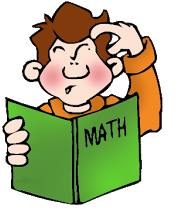
Many people think that they fit into one of two categories, “numbers people” and “words people.” Numbers people have a field day with equations and graphs and formulas, and can look at a set of numbers and can immediately recognize a pattern. Words people are readers, writers, they can great pronunciation skills, and can use context clues to help them understand a word or idea they’ve never heard of. But many people don’t know that being a words person can be a great benefit in the math classroom too! 🤓
Having strong reading comprehension skills makes understanding and dissecting math word problems a lot easier than not having a solid reading foundation. Here are a few tricks words people use to understand and solve word problems:
Read through the entire problem first
Words people understand that you have to get through the whole story, article or passage to really understand the entire idea. It doesn’t make sense to stop halfway through an article or essay and try to summarize the entire thing, right? So why do that with a math problem? Read the entire math problem all the way through so you have a clear understanding of what is being asked of you. Sometimes there are sentences that are totally useless and just there to throw you off. Cross them out so you don’t even think about them as you go back and re-read.
Go back and read again
This time, break the problem apart sentence by sentence. Write down what you know about the first sentence (numbers, equations, unknown variables.) Do this for every sentence, and the math will start to come alive from the words. Look for key words that give you clues on the type of math you will be doing. Words like difference between, fewer than, and decreased by give you clues you will be subtracting, while words like combined and sum mean you’re going to add. 🔎
Stay Organized
Begin working with what you know in a clear and organized fashion. Try your best to keep your numbers easy to read, your math signs bold and obvious, and pay attention to important (but easy to miss) details like when you are working with negative numbers. Nothing is more frustrating than getting the answer right, except you forgot to put the negative sign, making it incorrect. 🗒️
Do the Math
Now that your word problem has specific numbers and functions assigned to it, you can treat it like a typical math problem and solve accordingly.
Sometimes, math people freak out when you add letters and words to their problems. But if you are able to find the numbers and directions hidden in all of those letters, you’ll be a word problem solving pro in no time!





